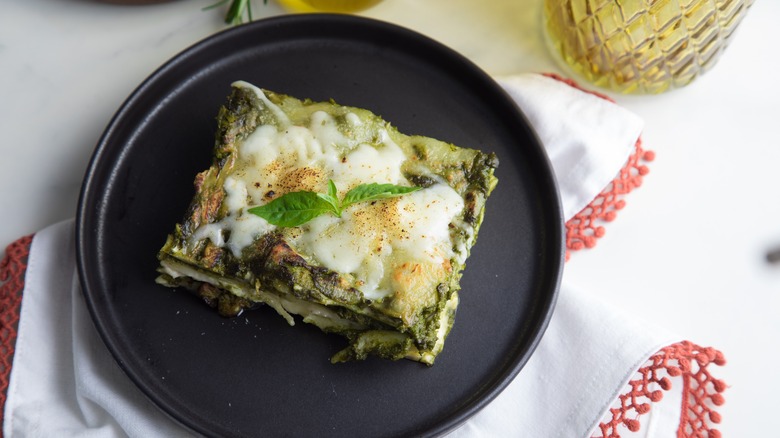Why Tourists Won't Even Recognize Lasagna In Italy, According To The Locals
The perfect comfort food, the beloved cheese, meaty, saucy dish, the quintessential baked pasta: Lasagna. For many travelers, the local cuisine is one of the highlights of a trip to Italy. However, those expecting to find familiar versions of their favorites — like lasagna — may be in for a surprise. According to locals, authentic lasagna in Italy is a far cry from the bastardized American-Italian version (just like Italian salad dressing and pepperoni pizza), and this culinary shock can leave some wondering if they're even eating the same dish at all.
Tex-Mex lasagna? Chicken lasagna? Gargantuan lasagna with heaps of melted mozzarella? That's not Italian lasagna; that's American-Italian lasagna. The local Italian friend of renowned travel guide Rick Steves made an important distinction between the two while they were having dinner in Florence. In the U.S., lasagna is four inches thick and filled with mozzarella, while in Italy, lasagna is usually only two inches thick, and there is no mozzarella — an Italian would say that American lasagna is a culinary crime. In Italy, it's quality over quantity, while in America, it's quantity over quality. Plus, U.S. versions of Italian dishes usually have twice the number of ingredients.
Lasagna is actually an ancient Italian dish — in fact, one of the oldest pasta dishes in the whole domain of Italian cuisine — with archaeological evidence on the table to prove it. Fouth-century BC Etruscan frescoes show pasta-making tools and diners enjoying early-version lasagna, while written records, like the first-century Roman cookbook "De Re Coquinaria" (yes, they had those back in the day), describe a dish of layered dough, meats, and cheeses. A version of lasagna that resembles what we have today appeared in the 14th-century medieval cookbook "Liber de Coquina," featuring flat, boiled dough topped with cheese and spices.
Regional variations of lasagna in Italy
So, what can one expect from lasagna in Italy? Well, that depends on where you're having your lasagna. The regional diversity of Italy's cuisine means that lasagna in one region may be almost unrecognizable in another. For example, the quintessential version — or what most Italians consider peak-form lasagna — is from the Emilio-Romagna region. Three ingredients: Layers of paper-thin broad noodles, a ragu or Bolognese-style meat sauce, and béchamel. That's it. Now, if you order lasagna in Naples, you'll get the same wide, sometimes ruffled noodles, but with some surprise guests like local sausages, meatballs, mozzarella, ricotta, and hard-boiled eggs. How about a green lasagna? Well, that's what you'll get in the Liguria region. This lasagna involves egg noodles, basil pesto, and bechamel, topped with Parmigiano Reggiano and pine nuts (Tomatoes? Nowhere to be seen).
However, despite the vast differences among these regional contenders, they share one thing in common: lasagna is not an everyday dish. For Italians, lasagna is a star-of-the-meal dish reserved only for special occasions, like Christmas, wedding parties, or when important company comes over. They're not having a microwavable or oven-ready lasagna over there; no-no — lasagna is a painstakingly time-consuming recipe to put together. Cooking the ragu sauce alone can take hours! So, when you order lasagna at an authentic restaurant in Italy (like this best restaurant in Modena, according to Giada De Laurentiis), embrace the regional variation and be prepared for a dish that any nonna will be proud of — not some abomination you'll find at an Italian-American joint. You're in Italy, after all!

